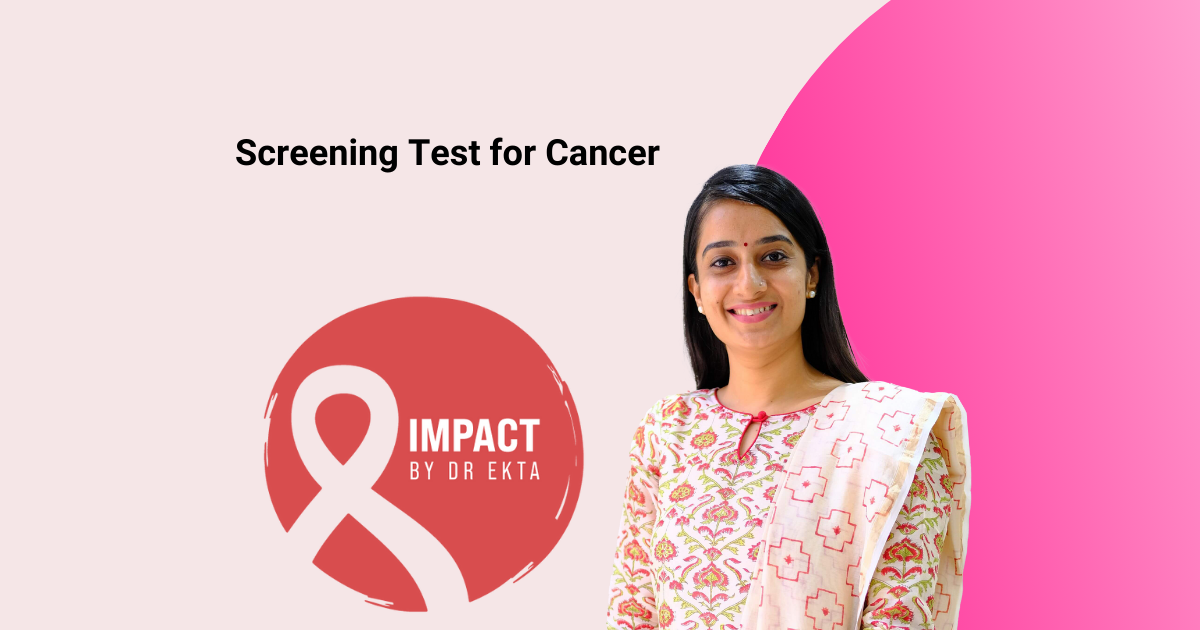Introduction
Hello, I’m Dr. Ekta Vala, an oncologist dedicated to the early detection and treatment of cancer. In my years of practice, I have seen firsthand how a screening test for cancer can be a game-changer. Early detection through screening tests not only improves the chances of successful treatment but also significantly enhances the quality of life for patients. In this blog, I’ll share vital information about the different types of screening test for cancer, their importance, and what you need to know to stay proactive about your health.
Understanding Screening Tests for Cancer
A screening test for cancer is a medical test performed on individuals without any symptoms of the disease. The primary goal is to detect cancer at an early stage when treatment is more likely to be successful. Unlike diagnostic tests, which are performed when symptoms are already present, screening tests aim to identify cancer in its nascent stages, potentially before it has spread.
Types of Screening Tests for Cancer
There are several types of screening test for cancer, each designed to detect specific types of cancer. Here are some of the most common:
- Mammograms: Used to screen for breast cancer, mammograms are X-ray images of the breast that can detect tumors that are too small to be felt. Regular mammograms can reduce the risk of dying from breast cancer.
- Pap Smears and HPV Testing: These tests are used to screen for cervical cancer. A Pap smear involves collecting cells from the cervix to look for abnormalities, while HPV testing checks for the presence of human papillomavirus, a major cause of cervical cancer.
- Colonoscopy: This test screens for colorectal cancer by examining the colon and rectum for polyps or cancerous growths. Early detection through colonoscopy can prevent colorectal cancer by allowing for the removal of precancerous polyps.
- Low-Dose CT Scans: Recommended for individuals at high risk for lung cancer, such as heavy smokers, this test uses low-dose computed tomography to detect lung cancer at an early stage.
- PSA Tests: Prostate-specific antigen (PSA) tests measure the level of PSA in the blood, which can be an indicator of prostate cancer. Elevated PSA levels may prompt further testing to diagnose or rule out prostate cancer.
- Skin Examinations: Regular skin exams by a healthcare professional or self-exams can help detect skin cancer early. Any new or changing moles or skin lesions should be evaluated promptly.
Who Should Get Screened?
The decision to undergo a screening test for cancer depends on various factors, including age, gender, family history, and lifestyle. Here are some general guidelines:
- Breast Cancer: Women aged 40 and above should consider annual mammograms, especially those with a family history of breast cancer.
- Cervical Cancer: Women aged 21 to 65 should have a Pap smear every three years. Women over 30 may opt for HPV testing every five years.
- Colorectal Cancer: Adults aged 50 and older should undergo regular colonoscopies. Those with a family history of colorectal cancer may need to start screening earlier.
- Lung Cancer: High-risk individuals, such as long-term smokers aged 55 to 80, should consider annual low-dose CT scans.
- Prostate Cancer: Men aged 50 and above should discuss PSA testing with their healthcare provider, especially if they have a family history of prostate cancer.
- Skin Cancer: Individuals should perform regular self-exams and have annual skin exams by a dermatologist, particularly if they have a history of excessive sun exposure or skin cancer.
Benefits and Risks of Screening Tests for Cancer
While the benefits of early detection are significant, it’s essential to be aware of the potential risks associated with screening test for cancer. These may include:
- False Positives: A test result that suggests cancer when there is none can lead to unnecessary anxiety and further invasive testing.
- False Negatives: A test result that misses the presence of cancer can provide false reassurance.
- Overdiagnosis: Detecting cancers that may never cause symptoms or harm during a person’s lifetime can lead to overtreatment.
- Physical Risks: Some screening tests involve radiation exposure or invasive procedures, which carry their own risks.
Despite these potential drawbacks, the benefits of timely screening test for cancer often outweigh the risks, particularly for individuals at higher risk for certain types of cancer.
How to Prepare for a Screening Test
Preparing for a screening test for cancer can vary depending on the type of test. Here are some general tips:
- Mammograms: Avoid using deodorants or lotions on the day of the test, as these can interfere with the images.
- Pap Smears and HPV Testing: Schedule the test when you are not menstruating, and avoid intercourse, douching, or using vaginal products for 24 hours before the test.
- Colonoscopy: Follow the dietary restrictions and bowel preparation instructions provided by your healthcare provider to ensure a clear view of the colon.
- Low-Dose CT Scans and PSA Tests: No special preparation is typically needed, but it’s essential to discuss your medical history and any concerns with your healthcare provider beforehand.
- Skin Examinations: Perform regular self-exams and keep track of any changes in your skin. Note any new or changing moles or lesions to discuss with your dermatologist.
Conclusion
As an oncologist, I cannot overemphasize the importance of regular screening test for cancer. These tests play a crucial role in catching cancer early, often before symptoms appear, which can significantly improve the chances of successful treatment and survival. By understanding the different types of screening test for cancer, knowing when to get screened, and being aware of the benefits and risks, you can take proactive steps to protect your health. Remember, early detection saves lives. Stay informed, stay vigilant, and make regular cancer screenings a part of your health routine.

